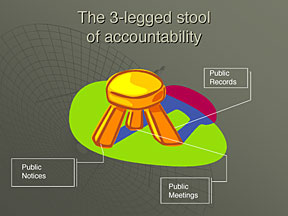Will the public be notified of water problems? Depends on notice laws in your state
Jun 26, 2024
Newspapers have reprint permission for the op-ed below by NNA Chair John Galer, publisher of The Journal-News, Hillsboro, Illinois. Download as Word doc here. Galer's headshot is embedded in the Word doc.
If you are aware of the Marion County (Kansas) Record, it is probably because you winced at the dings and dents inflicted upon the First Amendment when the local police department conducted a raid on the Record’s offices in 2023. Publisher Eric Meyer stood up to the police with a civil liberties lawsuit, put his paper out in spite of the harassment from law enforcement and reminded audiences all over the country about the importance of community newspapers.
What you might not know is that the Record is at it again — this time exposing the damage to the public’s right to know when water quality public notices are entrusted to self-reporting on government websites.
Ironically, the Record is in the same state whose attorney general recently gave Wichita — the state’s largest city — the ability to eliminate its newspaper notices and instead publish on the city’s website.
How well does this self-reporting work? We need only to look to the EPA’s and state agencies’ reporting requirements for water quality.
EPA used to require a newspaper notice. Then it “modernized” its methodology and set up a three-tied communications system for alerting the public to drinking water problems. The new guidance now doesn’t even mention newspapers. For immediate risks to human health, the only requirement for use of news media is a mention to broadcast media (remember them—they are the ones who no longer have local reporters in a majority of their markets.) Presumably, this notification would be through a press release. Translation: free media. Presumably, the broadcast outlet would be free to ignore it or forget to read their email to pick it up in the first place.
The water agency also can post the notice in “conspicuous locations.” We are remembering a recent public health experience when most people didn’t go outside their homes. We wonder which “conspicuous locations” would have served then. Hand delivery of notices to persons served by the water system is also allowed. We are betting that is a rare occurrence.
How well does this new system work?
Not so well, according to EPA’s inspector general. Agencies responsible for issuing public notices failed to meet requirements about 6,000 times per year on average. As a result, citizens were not notified that the Safe Drinking Water Act passed by Congress in 1974 was not being followed. In short, people might have been drinking polluted water, unaware.
After the debacles in Flint, Michigan, where taxpayers had to foot millions of dollars in damages and legal fees for drinking water problems — per the existence of polyfluoroalkyl substances (PFAS) in water near key military bases in North Carolina and Georgia — a person might think water quality would be higher on enforcing agencies’ agendas.
Back to Marion, Kansas.
The notice used by the city water authorities was a copy of a compliance report included in water bills. But one month, the report didn’t show up. Meyer went on the hunt. He was met with defensiveness and accusations, according to his news story. Finally, he found a mention in one water bill of an internet address for a water quality report. And it turned out a link to the report was on the city website. But, lo, when Meyer followed the link, he got a “Forbidden” notice. He reported a series of deflections by city official: they couldn’t get testing supplies from a vendor, tests were not really required because it had stopped using one disinfectant after its injectors failed. On and on.
To Meyer’s credit, he doesn’t let the ire of city administrations stop him. We hope his readers love his temerity and that his readers find out what they need to know about their local water. Meanwhile, we hope the Kansas attorney general gets a wake-up call.
What’s wrong with this picture?
As with all of the wishful thinking that goes into removing newspaper public notices and requiring the public’s business to be posted on some obscure website, the ability of the public to educate itself gets washed away. If Marion County’s 11,000-some residents had at least been given a shot at real public notice, they might have found the water was bad. Or that it was safe. Either way, they could have found out. But EPA let the water authorities off the public notice hook. And now the state has allowed its attorney general to further the error in Wichita.
The problem is that lack of notice removes, in Marion’s case, some 11,000 private attorneys general who might have chosen to hold their government accountable. But none the wiser, they could not.
What will it take? As in all defenses of liberty, eternal vigilance. We can never give up on the right to know.
--National Newspaper Association Chair John Galer, publisher, The Journal-News, Hillsboro, Illinois










